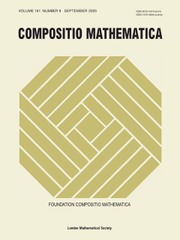No CrossRef data available.
Article contents
Rational ellipticity of G-manifolds from their quotients
Published online by Cambridge University Press: 09 June 2025
Abstract
We prove that if a compact, simply connected Riemannian G-manifold M has orbit space  $M/G$ isometric to some other quotient
$M/G$ isometric to some other quotient  $N/H$ with N having zero topological entropy, then M is rationally elliptic. This result, which generalizes most conditions on rational ellipticity, is a particular case of a more general result involving manifold submetries.
$N/H$ with N having zero topological entropy, then M is rationally elliptic. This result, which generalizes most conditions on rational ellipticity, is a particular case of a more general result involving manifold submetries.
Information
- Type
- Research Article
- Information
- Copyright
- © The Author(s), 2025. The publishing rights in this article are licensed to Foundation Compositio Mathematica under an exclusive licence
References
Burago, D., Burago, Y. and Ivanov, S., A Course in Metric Geometry (American Mathematical Society, Providence, RI, 2001).CrossRefGoogle Scholar
Burago, Y., Gromov, M. and Perel’man, G., A.D. Alexandrov spaces with curvature bounded below, Russian Math. Surveys 2 (1992), 1–58.CrossRefGoogle Scholar
Félix, Y., Halperin, S. and Thomas, J.-C., Rational Homotopy Theory (Springer, New York, NY, 2001).CrossRefGoogle Scholar
Friedlander, J. B. and Halperin, S., An arithmetic characterization of the rational homotopy groups of certain spaces, Invent. Math. 53 (1979), 117–134.CrossRefGoogle Scholar
Grove, K. and Halperin, S., Dupin hypersurfaces, group actions and the double mapping cylinder, J. Differential Geom. 26 (1987), 429–459.CrossRefGoogle Scholar
Grove, K., Wilking, B. and Yeager, J., Almost non-negative curvature and rational ellipticity in cohomogeneity two, Ann. Inst. Fourier 69 (2019), 2921–2939.CrossRefGoogle Scholar
Grove, K. and Ziller, W., Polar manifolds and actions, J. Fixed Point Theory Appl. 11 (2012), 279–313.CrossRefGoogle Scholar
Kleiner, B. and Lott, J., Geometrization of three-dimensional orbifolds via Ricci flow, Astérisque 365 (2014), 101–177.Google Scholar
Lytchak, A. and Kapovich, V., Structure of submetries, Geom. Topol. 26 (2022), 2649–2711.Google Scholar
Lytchak, A. and Thorbergsson, G., Curvature explosion in quotients and applications, J. Differential Geom. 85 (2010), 117–140.CrossRefGoogle Scholar
Mendes, R., Extending tensors on polar manifolds, Math. Ann. 365 (2016), 1409–1424.CrossRefGoogle Scholar
Mendes, R. and Radeschi, M., Laplacian algebras, manifolds submetries and their inverse invariant theory problem, Geom. Funct. Anal. 30 (2020), 536–573.CrossRefGoogle Scholar
Paternain, G. P., Geodesic flows, Progress in Mathematics, vol. 180 (Birkhäuser, Boston, 1999).CrossRefGoogle Scholar
Paternain, G. P. and Paternain, M., Topological entropy versus geodesic entropy, Internat. J. Math. 5 (1994), 213–218.CrossRefGoogle Scholar
Paternain, G. P. and Petean, J., Zero entropy and bounded topology, Comment. Math. Helv. 81 (2006), 287–304.CrossRefGoogle Scholar
Samani, E.K. and Radeschi, M., On the topology of leaves of singular Riemannian foliations, Rev. Mat. Iberoam. 40 (2024), 111–128.Google Scholar
Verona, A., Stratified mappings – structure and triangulability, Lecture Notes in Mathematics, vol. 1102, Subseries: Mathematisches Institut der Universität und MPI, Bonn, vol. 4 (Springer, Berlin, 1984).Google Scholar


